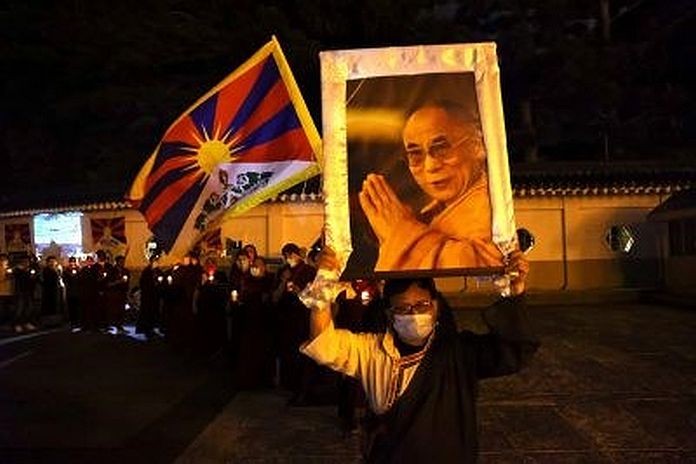By Dolma Tsering
Taiwan and the exile Tibetan community share a unique relationship amalgamated by the nexus of China, historical baggage, the relationship between the United States, China and India, and the growing influence of Tibetan Buddhism. The recent high-level meeting between the new Sikyong (political leader) of the Tibetan exile government and Taiwan’s India representative for the first time in a decade is an embodiment of the complex nexus of the relationship.
After moving to Taiwan, the Kuomintang (KMT) re-established the Mongol and Tibetan Affairs Commission and the constitutional provision to assert sovereignty over Tibet. The exile government criticised KMT activities, especially its collaboration with Tibetan anti-Chinese guerrilla group Chu-Shi Gang Druk and the establishment of another Tibetan cabinet office in 1969. These activities not only challenged the sovereignty of the exile government but were accused of creating chaos within the exile community. Consequently, they share a hostile and contentious relationship.
The internationalisation of the Tibet issue after intervention by the United States and the European Union, the Dalai Lama’s Nobel Prize and political development within Taiwan in the late 1980s moulded a new path for the relationship. The decision by Taiwan’s first elected president, Li Teng-hui, to invite the Dalai Lama to visit the island in 1992 and the Dalai Lama’s first visit in 1997 marked the beginning of a new friendship. A major outcome of the visit was Taiwan’s first recognition of the exile government and the establishment of an Office of Tibet in Taiwan.
The relationship strengthened during Chen Shui-bian’s presidency with a series of high-level diplomatic engagements. Chen invited a Tibetan exile government delegation to the inauguration of his second term. Over 100 Tibetan immigrants who had been enlisted as illegal immigrants received right of residency in Taiwan. Chen announced that the exiled Tibetans would be treated as ‘foreigners’ instead of Chinese, meaning visa applications would be processed by the ministry of foreign affairs instead of the ministry of interior.
But this celebratory period in Taiwan-Tibet relations was short-lived with a change of political leadership in Taiwan. Former president Ma Ying-jeou aimed to normalise cross-strait relations with China. Ma avoided the Dalai Lama during his third visit to Taiwan in 2009 to pray for and bless the victims of a typhoon that killed 463 people. In 2016, current president Tsai Ing-wen’s victory gave hope for positive change in the relationship and the possibility of the Dalai Lama’s fourth visit. But such positive developments have failed to materialise.
Tsai, unlike her predecessor, refrains from provoking Beijing and works to maintain stability in the region. There was major controversy when her government rescinded the visas of the Dalai Lama and Uyghur activist Rebiya Kadeer to attend a forum about religious freedom in Taiwan. During this period, a series of exiled Tibetan delegations visited Taiwan, but their meetings were confined to NGOs and a few Democratic Progressive Party legislative members.
In 2021, after a decade of absence, there has been a series of diplomatic interactions between Taiwan and the exile Tibetan government. These recent diplomatic interactions played out after the United States and India’s engagement and in the wake of growing concerns over China’s wolf war diplomacy.
This recent development reflects that external forces influence Taiwan and exile Tibetan relations. Given the dynamics of the US–China relationship and the growing sensitivity of cross-strait relations, the current intervention from the United States and India is less likely to have a major impact on reshaping relations as it did in the 1980s and 2000s. Although the Democratic Progressive Party caucus has always expressed more sympathy towards the Tibet issue, the priority of cross-strait peace is increasing within Taiwan.
Other elements of the relationship are shaped by non-political factors, like religion and human rights. In the absence of high-level engagement, these two factors played a significant role in deepening cooperation and understanding between the two communities. Over the past two decades, there have been limited academic and cultural exchanges primarily due to an immigration law restricting student and resident visas for Tibetan students and exile Tibetan people in general.
The current development is an opportunity to discuss non-political areas of cooperation, like education and cultural exchanges. Both parties can negotiate and find a solution that is mutually beneficial. Religion, culture, human rights and education should be the foundation of the relationship in the long term.
Dolma Tsering is a Post-Doctoral Fellow in the Humanities and Social Science Research Centre at National Cheng Kung University, Taiwan.
This article originally appeared on EastAsiaForum on November 29, 2021.





